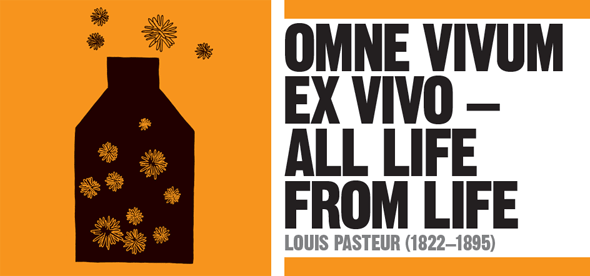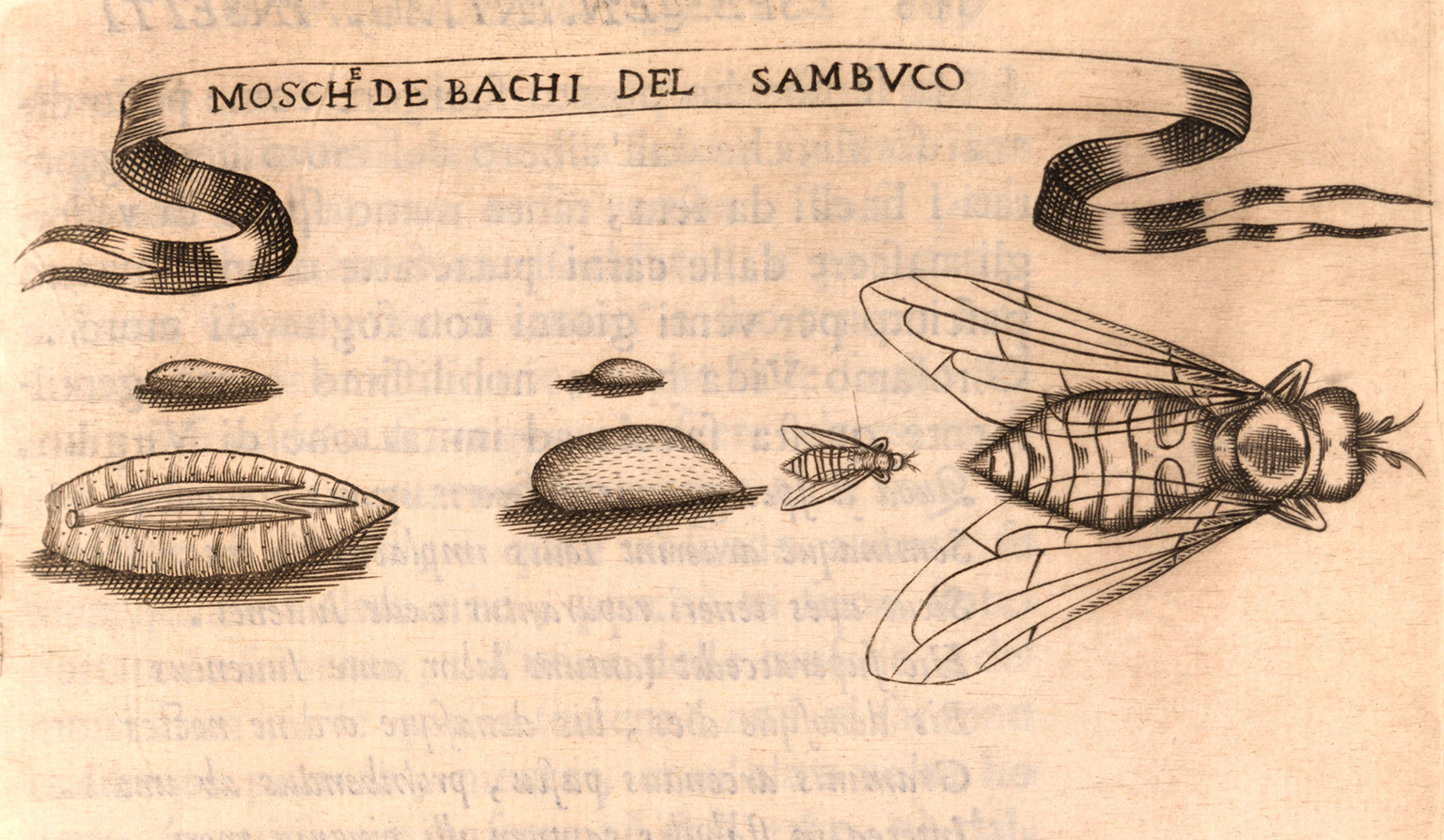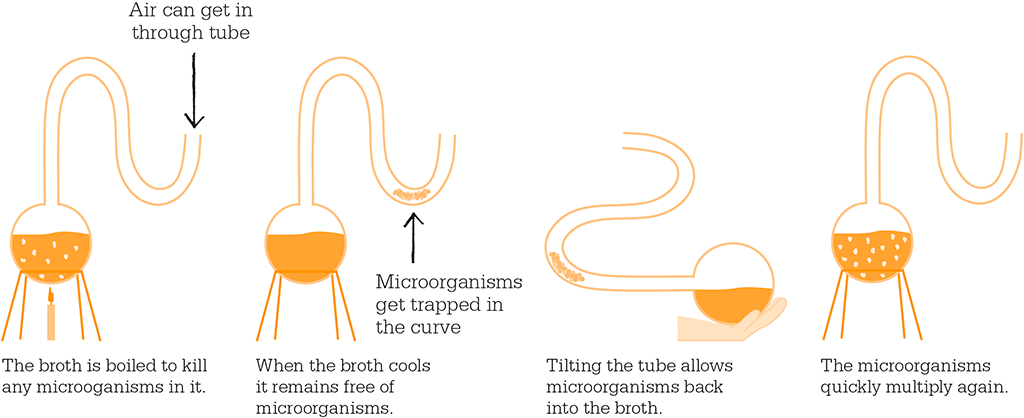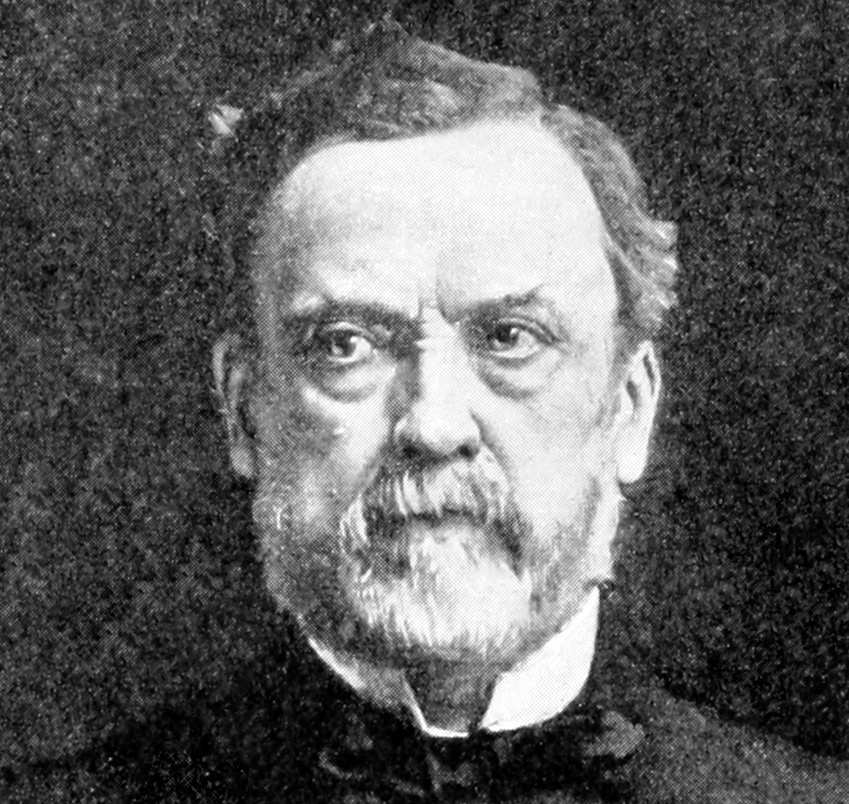
IN CONTEXT
Biology
1668 Francesco Redi demonstrates that maggots arise from flies – and not spontaneously.
1745 John Needham boils broth to kill microbes, and believes that spontaneous generation has occurred when they grow back.
1768 Lazzaro Spallanzani shows that microbes do not grow in boiled broth when air is excluded.
1881 Robert Koch isolates microbes that cause disease.
1953 Stanley Miller and Harold Urey create amino acids – essential to life – in an experiment that simulates origin-of-life conditions.
Modern biology teaches that living things can only arise from other living things by a process of reproduction. This may seem self-evident today, but when the basic principles of biology were in their infancy, many scientists adhered to a notion called “abiogenesis” – the idea that life could spontaneously generate itself. Long after Aristotle claimed that living organisms could emerge from decaying matter, some even believed in methods that purported to make creatures from inanimate objects. In the 17th century, for instance, Flemish physician Jan Baptista von Helmont wrote that sweaty underwear and some wheat grain left in a jar in the open would spawn adult mice. Spontaneous generation had its advocates until well into the 19th century. In 1859, however, a French microbiologist named Louis Pasteur devised a clever experiment that disproved it. In the course of his investigations, he also proved that infections were caused by living microbes – germs.
Before Pasteur, the link between disease or decay and organisms had been suspected but never substantiated. Until microscopes could prove otherwise, the notion that there were such things as tiny living entities that were invisible to the naked eye seemed fanciful. In 1546, Italian physician Girolamo Fracastoro described “seeds of contagion”, and came close to the truth of the matter. But he fell short of explicitly stating that they were living, reproducible things, and his theory made little impact. Instead, people believed that infectious disease was caused by “miasma” – or noxious air – that came from rotting matter. Without a clear idea of the nature of germs as microbes, no one could properly appreciate that the transmission of infection and the propagation of life were in effect two sides of the same coin.

"In the field of experimentation, chance favours only the prepared mind."
Louis Pasteur
First scientific observations
In the 17th century, scientists attempted to trace the origins of larger creatures by studying reproduction. In 1661, English physician William Harvey (known for his discovery of the circulation of blood) dissected a pregnant deer in an effort to discover the origin of a foetus, and proclaimed “Omne vivum ex ovo” – all life from eggs. He failed to find the deer’s egg in question, but it was at least a hint of things to come.
Italian physician Francesco Redi was the first to offer experimental evidence for the impossibility of spontaneous generation – at least in so far as creatures visible to the human eye were concerned. In 1668, he studied the process by which meat becomes riddled with maggots. He covered one piece of meat with parchment and left another exposed. Only the exposed meat became infected with maggots, because it attracted flies, which deposited their eggs on it. Redi repeated the experiment with cheesecloth – which absorbed the meat’s odour and attracted flies – and showed that flies’ eggs taken from the cheesecloth could then be used to “seed” uninfected meat with maggots. Redi argued that maggots could only arise from flies, rather than spontaneously. However, the significance of Redi’s experiment was not appreciated, and even Redi himself did not fully reject abiogenesis, believing that it did occur in certain circumstances.
Among the first makers and users of the microscope for detailed scientific study, Dutch scientist Antonie van Leeuwenhoek showed that some living things were so small that they could not be seen with the naked eye – and also that the reproduction of larger creatures depended upon similar microscopic living entities, such as sperm.
Yet the idea of abiogenesis was so deeply entrenched in the minds of scientists that many still thought that these microscopic organisms were too small to contain reproductive organs and must therefore arise spontaneously. In 1745, English naturalist John Needham set out to prove it. He knew that heat could kill microbes, so he boiled some mutton gravy in a flask – thereby killing its microbes – and then allowed it to cool. After observing the broth for a time, he saw that the microbes had come back. He concluded that they had arisen spontaneously from the sterilized broth. Two decades later, Italian physiologist Lazzaro Spallanzani repeated Needham’s experiment, but showed that the microbes did not grow back if he removed air from the flask. Spallanzani thought that the air had “seeded” the broth, but his critics proposed instead that air was actually a “vital force” for the new generation of microbes.
Viewed in the context of modern biology, the results of Needham’s and Spallanzani’s experiments can be easily explained. Although heat does indeed kill most microbes, some bacteria, for example, can survive by turning into dormant, heat-resistant spores. And most microbes, as with most life, need oxygen from the air in order to derive energy from their nutrition. Most importantly, however, these sorts of experiments were always vulnerable to contamination – microscopic air-borne microbes can easily colonize a growth medium, even after a brief exposure to the atmosphere. So in fact, neither of these experiments had addressed conclusively the question of abiogenisis, one way or another.

This drawing by Francesco Redi shows maggots turning into flies. His work showed not only that flies come from maggots, but also that maggots come from flies.
"I intend to suggest that no such thing as abiogenesis has ever taken place in the past, or ever will take place in the future."
Thomas Henry Huxley
Conclusive proof
A century later, microscopes and microbiology had advanced far enough for it to became possible to settle the matter. Louis Pasteur’s experiment demonstrated that there were microbes suspended in air, ready to infect any exposed surface. First, he filtered air through cotton. Then he analysed the contaminated cotton filters and examined the trapped dust with a microscope. He found it to be teeming with the sort of microbes that had been linked with the decay and spoilage of food. It looked as though infection was caused when microbes literally fell out of the air. This was the critical information Pasteur needed to succeed in the next step, when he took up a challenge laid down by the French Academy of Sciences – to disprove the idea of spontaneous generation once and for all.
For his experiment, Pasteur boiled nutrient-rich broth – just as Needham and Spallanzani had done a century before – but this time made a critical modification to the flask. He heated the flask’s neck to soften the glass, then drew the glass outwards and downwards to form a tube in the shape of a swan’s neck. When the set-up had cooled, the tube was part-way directed downwards so that microbes could not fall onto the broth, even though the temperature was now suitable for their growth and there was plentiful oxygen as the tube communicated with the outside air. The only way microbes could grow back in the flask was spontaneously – and this did not happen.
As final proof that microbes needed to contaminate the broth from the air, Pasteur repeated the experiment, but snapped off the swan-necked tube. The broth became infected: he had finally disproved spontaneous generation, and had shown that all life came from life. It was clear that microbes could no more spontaneously appear in a flask of broth than mice could appear in a dirty jar.

Pasteur’s swan-neck experiment proved that a sterilized broth will remain free of microorganisms for as long as they are prevented from falling into it from the air.
Abiogenesis returns
In 1870, English biologist Thomas Henry Huxley championed Pasteur’s work in a lecture entitled “biogenesis and abiogenesis”. It was a crushing blow to the last devotees of spontaneous generation, and marked the birth of a new biology solidly founded on the disciplines of cell theory, biochemistry, and genetics. By the 1880s, German physician Robert Koch had shown that the disease anthrax was transmitted by infectious bacteria.
Nevertheless, nearly a century after Huxley’s address, abiogenesis would once again focus the minds of a new generation of scientists as they began to ask questions about the origin of the very first life on Earth. In 1953, American chemists Stanley Miller and Harold Urey sent electrical sparks through a mix of water, ammonia, methane, and hydrogen to simulate the atmospheric conditions at the dawn of life on Earth. Within weeks, they had created amino acids – the building blocks of proteins and key chemical constituents of living cells. Miller and Urey’s experiment triggered a resurgence of work aimed at showing that living organisms can emerge from non-living matter, but this time scientists were equipped with the tools of biochemistry and an understanding of processes that took place billions of years ago.
"I observe facts alone; I seek but the scientific conditions under which life manifests itself."
Louis Pasteur
LOUIS PASTEUR

Born to a poor French family in 1822, Louis Pasteur became such a towering figure in the world of science that, upon his death, he was given a full state funeral. After training in chemistry and medicine, his professional career included academic positions at the French universities of Strasbourg and Lille.
His first research was on chemical crystals, but he is better known in the field of microbiology. Pasteur showed that microbes turned wine into vinegar and soured milk, and developed a heat-treating process that killed them – known as pasteurization. His work on microbes helped to develop modern germ theory: the idea that some microbes caused infectious disease. Later in his career, he developed several vaccines, and established the Institut Pasteur devoted to the study of microbiology, which thrives to this day.
Key works
1866 Studies on Wine
1868 Studies on Vinegar
1878 Microbes: Their Roles in Fermentation, Putrefaction, and Contagion